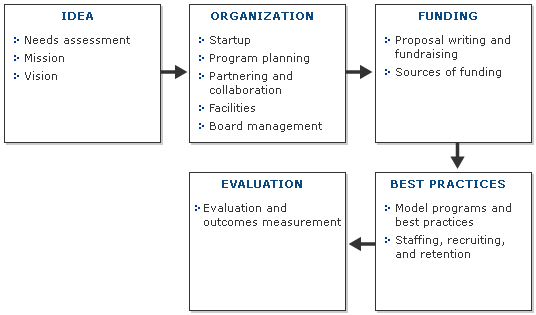Introduction
Starting and running a youth program has a sort of "flow." The steps you need to take depend on where you are in the process. Take a look at this diagram to get a sense of the areas in which you might need help:

- You may be in the idea stage if you are trying to figure out exactly how you want to help young people.
- If you already have a thought-out idea but you need the organizational structure and partners to make it happen, you may be in the organization stage.
- When you've already come up with the design for a program, but you need cash or other resources to put it in place, this is the funding stage.
- Once you've got an established organization or program, but you feel there's room for improvement, you're in the best practices stage.
- When you want to prove that you're accomplishing what you set out to do with a program that's up and running, this is the evaluation stage.
You may have noticed that the stages overlap and that some tasks, such as fundraising and evaluation, happen continually rather than at one particular moment in the life of a program.
NOTE: Inclusion of links to websites and publications in this guide does not imply an endorsement of those resources, or of the opinions expressed in them, by the National Clearinghouse on Families & Youth, the Family and Youth Services Bureau, or the U.S. Department of Health and Human Services.
Focusing on the Positive
First, a few words about taking a positive approach to working with young people. Positive Youth Development, or PYD, has proved to be especially effective as an overarching framework for youth services.
PYD is the idea that, given guidance and support from caring adults, all youth can grow up healthy and happy, making positive contributions to their families, schools, and communities. Organizations that use PYD to underpin their youth work favor leadership and skill-building opportunities, which give youth feelings of competence and power.
PYD includes the concept of "youth involvement." Involving youth might mean helping them to create their own treatment plans and to envision their own life goals, inviting them to serve on your board, soliciting their input on new programs, asking them to plan an event with adult support, giving them opportunities to serve their communities, or simply empowering them to make their own choices. Youth involvement is always coupled with adult support and guidance.
In a similar vein, organizations should strive to involve families, schools and communities in their work. For more information about how to do this, visit FindYouthInfo.gov.
Many Ways to Help Young People
Before you jump into the world of designing programs for young people, ask yourself a question: "Can I help youth in my community without starting something new?"
One way to help young people is to get involved with an already existing organization. Many youth-serving organizations need volunteers, board members, donors, and qualified staff members.
Before you get started, you may want to learn what's already happening in your community. You can do so by consulting FindYouthInfo.gov, which includes a searchable database of youth programs.
Another way to find a youth-serving agency near you is to visit the Family and Youth Services Bureau website to locate federally funded programs that shelter runaway and homeless youth, mentor children of prisoners, and work to prevent teen pregnancy.
You might also contact a local school or community center, your state's department of health and human services, your local mentoring network, or a national youth-serving organization such as the National Runaway Switchboard, National Safe Place, 4-H, Boys and Girls Clubs of America, Big Brothers Big Sisters.
Using This Guide
But what if your town, neighborhood, or community lacks already established organizations or programs that meet the needs of young people? Then, you may want to continue reading for guidance on how to start your own program for youth. The following sections will take you through the stages of establishing a program, linking you to useful online resources along the way.
Of course, a website can't substitute for assistance from another human being. At every step on your road to launching a youth program, you can get help in a number of ways:
- Talk to established youth-serving agencies to make connections and get advice. One place to find such organizations is the interactive map of FYSB grantees.
- Get in touch with one of the many organizations that provide support services to nonprofits. Examples include CompassPoint Nonprofit Services in San Francisco and San Jose and Third Sector New England in Boston. Idealist, an online community for nonprofit workers, offers a list of national, local, and international support organizations.
- Contact a national organization that promotes youth work (such as the National Network for Youth, MENTOR and the National Afterschool Association) or your state or region's network of youth-serving agencies.


 Sign up
Sign up Follow us
Follow us Like us
Like us Sign up for our RSS feeds:
Sign up for our RSS feeds: 

